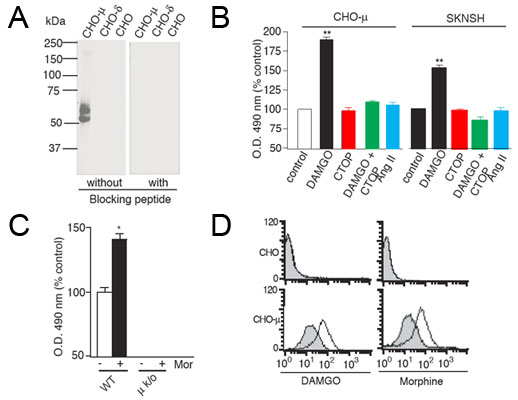Anti-Mu Opioid Receptor, N-terminal [NT2] Antibody
The NT2 monoclonal antibody (also known as 5G8) was generated against a multiple antigenic peptide to the N-terminal region of the µ-opioid receptor (MOP, MOR-1) and is cross-reactive with human, mouse and rat µ-opioid receptor.
NT2 is specific for the midportion of the N-terminal tail of MOP, which is exposed upon activation. The multiple antigenic peptide used to generate this MOP antibody was obtained by synthesizing multiple copies of the peptide sequence 14SDPLAPASCSPA25 on a poly-lysine backbone. NT2 is useful for studying G-protein-coupled receptor (GPCR) signaling, probing differential conformational states of GPCRs, or in the development of screening assays for the identification of novel small molecule ligands of therapeutic interest.
Mu Opioid Receptor, also known as Mu-type opioid receptor, functions as a class A GPCR. It is expressed in the brain and is involved in neurogenesis. MOP is the main physiological target for most clinically important opioid analgesics such as beta-endorphin, endomorphin, morphine, heroin, DAMGO, fentanyl, etorphine, buprenorphin and methadone. NT2 exhibits increased receptor recognition following treatment with agonists such as DAMGO, a result of conformational changes to the midregion of the N-terminal tail of the µ-opioid receptor.
From the laboratory of Lakshmi A. Devi, PhD, Icahn School of Medicine at Mount Sinai.
The NT2 monoclonal antibody (also known as 5G8) was generated against a multiple antigenic peptide to the N-terminal region of the µ-opioid receptor (MOP, MOR-1) and is cross-reactive with human, mouse and rat µ-opioid receptor.
NT2 is specific for the midportion of the N-terminal tail of MOP, which is exposed upon activation. The multiple antigenic peptide used to generate this MOP antibody was obtained by synthesizing multiple copies of the peptide sequence 14SDPLAPASCSPA25 on a poly-lysine backbone. NT2 is useful for studying G-protein-coupled receptor (GPCR) signaling, probing differential conformational states of GPCRs, or in the development of screening assays for the identification of novel small molecule ligands of therapeutic interest.
Mu Opioid Receptor, also known as Mu-type opioid receptor, functions as a class A GPCR. It is expressed in the brain and is involved in neurogenesis. MOP is the main physiological target for most clinically important opioid analgesics such as beta-endorphin, endomorphin, morphine, heroin, DAMGO, fentanyl, etorphine, buprenorphin and methadone. NT2 exhibits increased receptor recognition following treatment with agonists such as DAMGO, a result of conformational changes to the midregion of the N-terminal tail of the µ-opioid receptor.
From the laboratory of Lakshmi A. Devi, PhD, Icahn School of Medicine at Mount Sinai.
| Product Type: | Antibody |
| Antigen: | Mu Opioid Receptor (MOP) |
| Accession ID: | P35372 |
| Isotype: | IgG2b |
| Clonality: | Monoclonal |
| Clone Name: | NT2 (also known as 5G8) |
| Reactivity: | Human, Mouse, Rat |
| Immunogen: | Multiple antigenic peptide from the N-terminal region of the mu-opioid receptor (sequence: 14SDPLAPASCSPA25) |
| Species Immunized: | Mouse |
| Purification Method: | Protein A |
| Buffer: | 100 mM Tris-glycine, pH 7 |
| Tested Applications: | WB (1:500-1:1000), ELISA (1:100-1:500), FACS (1:100-1:400) |
| Storage: | -20C. Once thawed, store at 4C (avoid repeat freeze thaw cycles). |
| Shipped: | Cold packs |
Use of Anti-Mu Opioid Receptor, N-terminal (NT2) Antibody

(A) Western blot with NT2 mAb of CHO cell membranes expressing either mu or delta opioid receptors that were pre-incubated without or with the peptide SDPLAPASCSPA. (B) ELISA with NT2 mAb and CHO cells expressing mu opioid receptors or SKNSH cells that endogenously express mu opioid receptors. (C) ELISA with NT2 mAb and membranes from wild-type (WT) or mu knock-out mice that were treated without or with morphine. (D) FACS analysis with NT2 mAb and CHO cells alone (Top Panel) or CHO cells expressing mu opioid receptors (Bottom Panel) that were treated with the mu opioid receptor agonists DAMGO or morphine.
Adapted from: Gupta A, Décaillot FM, Gomes I, Tkalych O, Heimann AS, Ferro ES, Devi LA. Conformation state-sensitive antibodies to G-protein-coupled receptors. J Biol Chem. 2007 Feb 23;282(8):5116-24.
Important: NT2 mAb exhibits increases in recognition of agonist-treated opioid receptors only when cells/tissues expressing the receptors are treated with the agonists prior to brief fixation with ice-cold methanol.
-
Gupta A, Décaillot FM, Gomes I, Tkalych O, Heimann AS, Ferro ES, Devi LA. Conformation state-sensitive antibodies to G-protein-coupled receptors. J Biol Chem. 2007 Feb 23;282(8):5116-24.
If you publish research with this product, please let us know so we can cite your paper.

![Anti-Mu Opioid Receptor, N-terminal [NT2] Antibody Anti-Mu Opioid Receptor, N-terminal [NT2] Antibody](https://www.kerafast.com/MediaStorage/Product/Images/Medium/753_200120200126207520.jpg)
